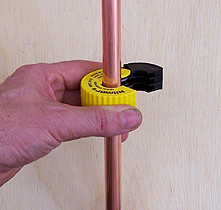 |
 |
Home
Tools
Drilling and Fixing
Putting Things Up
Repairs/Maintenance
Plumbing
Electrics
Woodwork
Decorating a Room
Tiling
Safety & Security
Saving Energy
House and Finance
Health&Safety
Disclaimer
Contact
Advertising
Useful Links
Site Map
| Replacing a tap | |||||||||||||||||||||
Make sure the water is turned off. Run the tap to make sure. (see section on turning off your water.) Bath taps can be very tricky indeed. For a beginner you may be more advised to get a plumber in. Sometimes with kitchen sinks I have on occasion found it easier to remove the sink to get better access to the tap! If you buy a new tap make sure it is rated for the water pressure you have in your home. e.g high pressure mains, or low pressure coming from a gravity heating system(with a water tank in your loft)
|
 |
||||||||||||||||||||
 |
|||||||||||||||||||||
| Basin wrench | |||||||||||||||||||||
 |
|||||||||||||||||||||
| Adjustable basin wrench. Copes with most sizes | |||||||||||||||||||||
| Mixer taps generally have a slightly different means of fixing. they use a metal collar and rubber washer held in place with a threaded shaft and nut(one or two depending on the brand) You'll need a small spanner to loosen/tighten this. Sometimes they also have a slot in the end of the nut which you can tighten with a long screwdriver. This can be quite tricky if you are in an awkward position. If you can't get a normal spanner on the nut try a box spanner. | 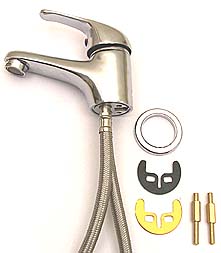 |
||||||||||||||||||||
 |
|||||||||||||||||||||
Box spanner 12 and 13 mm. Come in various sizes |
|||||||||||||||||||||
| Modern mono block mixer tap | |||||||||||||||||||||
|
|||||||||||||||||||||
Single taps |
|||||||||||||||||||||
Mixer taps |
|||||||||||||||||||||
Dealing with variations in sizes of tap shaft lengths |
|||||||||||||||||||||
If the pipe work to your old taps had flexible hose then fitting a new tap should be fairly straightforward. If you have solid copper pipes then unless your new taps are the same length it's going to be a bit more fiddly. These flexible hoses come in various lengths and two diameters either for a 15mm. copper pipe work (kitchen and basin taps) or 22mm copper pipes (bath taps) |
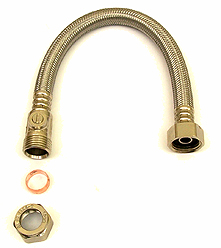 |
||||||||||||||||||||
| Flexible pipe. The one shown is 15mm. pipe compression fitting to 1/2inch tap screw fitting | |||||||||||||||||||||
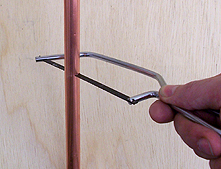 |
|||||||||||||||||||||
| Cutting copper pipe Use a junior hacksaw to cut the pipe to the length you need. NB if you use a this method make sure you then rub off any rough edges with some sand paper or emery paper |
|||||||||||||||||||||
|
|||||||||||||||||||||
An alternative is to buy a special pipe cutter. These are great. You simply clamp the cutter round the pipe and turn it until the pipe separates. It's really easy to use and you end up with a perfect cut with no sharp burrs as you do with a hacksaw so it's ready for your compression fitting. |
|||||||||||||||||||||
| To fit the hose to the pipe work firstly make sure the pipe has no sharp edges. File or sand off any burrs then clean up the end with some wire wool. The flexible pipe fitting come with push on fittings or compression joints. The push fit type simply pushes onto the pipe. (make sure you push it firmly into place as far as it will go). |
|||||||||||||||||||||
Next push the body of the hose on to the pipe and screw it up with the nut. Use spanners or mole grips and wrench to tighten up the nut. As you tighten it up the brass "olive" is compressed and creates a water tight seal. Make sure you get the nuts nice and tight. |
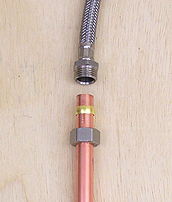 |
||||||||||||||||||||
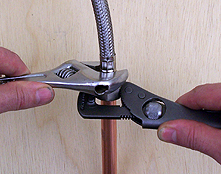 |
|||||||||||||||||||||
 |
|||||||||||||||||||||
Push fit connectors These are even easier to use though are generally a little more expensive. Make sure the pipe has no sharp edges. These work best when you've used the special pipe cutting tool shown above rather than a hack saw. Make sure the pipe is fully pushed into the fitting or it will leak. |
|||||||||||||||||||||
Flexible pipes There are quite a few to choose from e.g. tap to pipe, pipe to pipe |
|||||||||||||||||||||
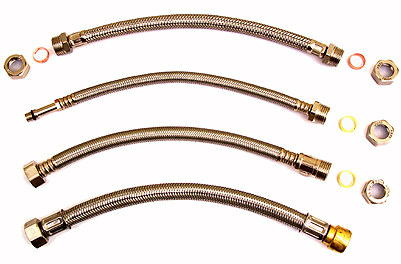 |
|||||||||||||||||||||
15mm. pipe to pipe (compression fitting) |
|||||||||||||||||||||
mixer tap to 15mm. pipe(compression) |
|||||||||||||||||||||
1/2 inch tap to 15mm. pipe (compression) |
|||||||||||||||||||||
1/2 inch tap to 15mm. pipe (push fit) |
|||||||||||||||||||||
